THE SWISS BALL CRUNCH SCOOP
They’ve been called fit balls, fitness balls, exercise balls, Swiss balls, stability balls, balance balls and a myriad of other names, but in my humble opinion the bottom line is: They rule! Just the simple act of sitting on a Swiss ball—my name of choice—requires the incorporation of your core muscles.
Documented tests (done by attaching an EMG machine to the exercising individual’s abdominal muscles while crunching) prove the Swiss ball crunch is one of the most effective core training exercises ever.
Whether your quest is core strength or six-pack abs, I highly suggest you become friends with a Swiss ball. So go ahead, don’t be afraid to hug it, squeeze it, and call it George.
SIZE COUNTS
Fitness balls come in different sizes. The basic rule for choosing the correct size is that when you're sitting on the ball, you should be able to easily balance with your feet on the ground. Your hips and knees should both be at right angles. The following list matches you up with the right size ball, based on your height:
- 55 centimeters if you're less than 5 feet tall.
- 65 centimeters if you're between 5 feet and 5 feet 7 inches tall.
- 75 centimeters if you're between 5 feet 8 inches and 6 feet 2 inches tall.
- 85 centimeters if you're over 6 feet 2 inches tall.
DON’T FEAR THE BALL!
If you are a long-time Swiss ball fan, you may not even remember the first time you sat on one and found yourself bobbing up and down and saying, "Ahhh, this is kinda fun." But for the novice wannabe ball users, it can be a scary maneuver.
Visions of embarrassing, ungraceful exhibitions of skill (falling on your face) may prevent you from ever reaping the benefits of these cool tools of body sculpture that sit teasingly in the corner of the gym. So, here is how I take my nervous clients for their virgin voyage on the Swiss ball cruise.
To sit on the ball: First, simply stand about 6-12 inches in front of the ball with your feet wide apart. A wide base helps provide balance once you're in the seated position. Next, carefully sit down on the ball, making sure there are several inches between the ball and your heels once you’re seated.
Now, take as much time as you need to get comfortable with how this feels. Gently bounce up and down and become acclimated to the ball and your body, and allow yourself to become confident with it. Remember, everyone had to start with their first time on the ball at some point. Your confidence and feeling of control will grow with each use.
To get off the ball from a lying position: You may laugh, but this is tricky for the novice ball user. This is where I seem to see people have the most difficulty. After you finish your Swiss ball crunch, or whatever lying exercise you just did, simply walk your feet back towards the ball while simultaneously coming back into a seated position on the ball. Then you can simply stand up.
To do a crunch:
- Sit on the ball and then walk your feet away while simultaneously going down into a lying position, allowing the ball to stop at the lumbar spine area or the lower back. Your feet should be flat on the floor and your knees should be bent at a 90 degree right angle.
- Place your hands across your chest (beginner) or behind your head (intermediate or advanced) and slightly curl you head neck and shoulders towards your pelvis.
- Exhale your air through your mouth as you come up and pause for a second as you empty your lungs completely at the top of the move, then slowly return to the start. Repeat for as many reps as you can until failure.
Tips: Envision doing an accordion-type contraction with your abdominal muscles. This is a subtle move of only a couple of inches. Remember, it is a crunch, not a sit-up. Never pull with your hands and always do slow, controlled moves—never bouncy or jerky. Keep the same distance between your chin and chest at all times (pretend you have an orange lodged there), leading with the shoulders-your head and neck are only along for the ride.
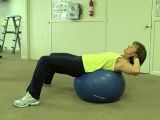
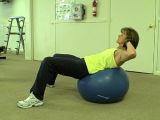
To do oblique crunches on stability ball: Do the same as above except as you come up twist your right shoulder towards your left knee and return to the start position. You may repeat for desired reps on the same side or alternate between opposite sides per rep. Remember, do these slow and controlled using the same careful technique as described above.
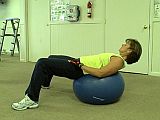
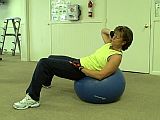
To do low-back hyperextensions on the Swiss ball:
- Kneel in front of the wall with feet far apart and toes against the wall. Hold exercise ball snug up against the front of your thighs and bend at the waist with your stomach on top of it, keeping your upper back flat. Do not round your back.
- Flatten heels up against the wall as you simultaneously raise your knees off the floor and straighten them into a soft-lock (almost straight) position.
- Place the hands clasped and palms up on lower back.
- Exhale as you slowly raise your torso until your legs and upper body are in a straight line. Do NOT arch your lower back past a straight line!
- Inhale as you return back down to the starting position.
- Repeat for the desired amount of reps.
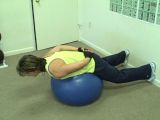
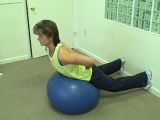
OTHER USES FOR THE SWISS BALL
We have only scratched the surface of the plethora of exercises you can do on the Swiss ball. You can do pretty much any free weight or cable exercise on the ball. Think of it as a round weight bench. Really, it is only as limited as your imagination and creativity.
Just remember that it definitely adds a degree of difficulty and challenge to anything you do because you have to factor in stabilizing your body and keeping proper alignment and posture throughout your moves. You may want to start with simple dumbbell biceps curls and shoulder presses and graduate into chest presses, flyes and from there the possibilities are endless.
So, there you have it…a very cool new toy to add to your arsenal of fitness paraphernalia. Go ahead…have a ball! And remember, practice makes perfect, so don’t give up. The Swiss Ball Crunch Rules!!
Return from Swiss Ball Crunch to Core Training
Return from Swiss Ball Crunch to Straightforward Home